Key takeaways:
- User engagement metrics like click-through rates and scroll depths are vital for understanding how to connect with audiences.
- High engagement correlates with increased conversions; innovative strategies, such as interactive content and optimized CTAs, can enhance user experience.
- Analyzing data effectively, including bounce rates and user pathways, reveals opportunities for improvement in content and user experience.
- Building a community and sharing personal insights foster deeper connections with the audience, leading to higher engagement.

Understanding User Engagement Metrics
User engagement metrics are powerful indicators of how visitors interact with your website. When I first delved into analytics, I was surprised to discover that metrics like time on page and bounce rates reveal so much about user behavior. Have you ever wondered why a page that seems appealing isn’t retaining visitors? That’s where these metrics come into play.
One metric that captivated me was the click-through rate (CTR). I remember analyzing a client’s campaign and realizing that despite high impressions, the CTR was disappointingly low. It struck me then how crucial it is to craft compelling calls to action. If users aren’t clicking, it raises the question: what’s missing in your content that might connect with your audience?
Diving deeper into engagement metrics like scroll depth revealed fascinating insights about content consumption. I once worked on a blog post where the average scroll depth was only 30%. It made me reconsider the layout and the storytelling approach we used. It’s not just about what you share; it’s about how you present it. Are you telling a story that keeps users scrolling, or is your content losing them halfway through?
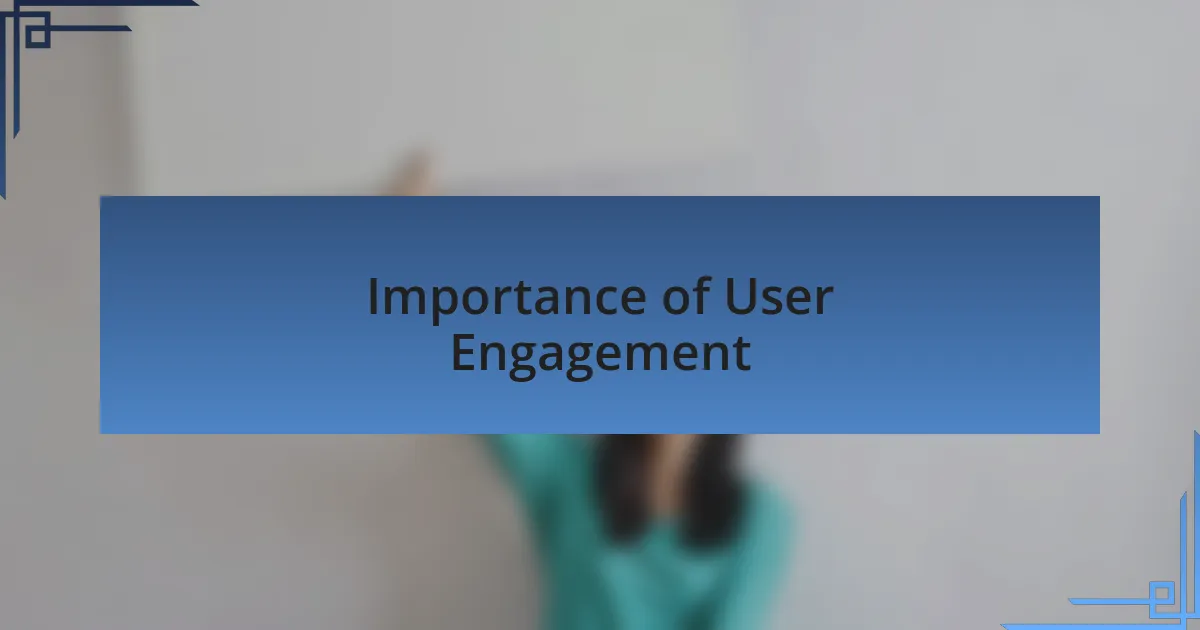
Importance of User Engagement
User engagement is the heartbeat of any website; it shows exactly how involved visitors are with your content. When I first noticed a dramatic drop in engagement on one site I managed, it hit me hard. It was a wake-up call that our audience wasn’t just looking for information; they craved connection and interaction. I started to wonder: how can we create experiences that resonate and keep users coming back?
Reflecting on my experiences, I realized that high engagement leads to increased conversions. I once developed an interactive quiz for a client, and the surge in user interaction was exhilarating. Users spent more time on the site, and we saw a notable increase in lead generation. It made me think: what innovative strategies can I implement next to deepen that connection?
Engagement isn’t merely about numbers; it’s about building relationships with your audience. In my early days, I focused solely on traffic, neglecting the importance of retaining that attention. I still remember the disappointment of seeing a high bounce rate. It prompted me to ask myself: how can I transform casual visitors into loyal followers? That challenge has driven my continuous quest to enhance user engagement and create value in every interaction.
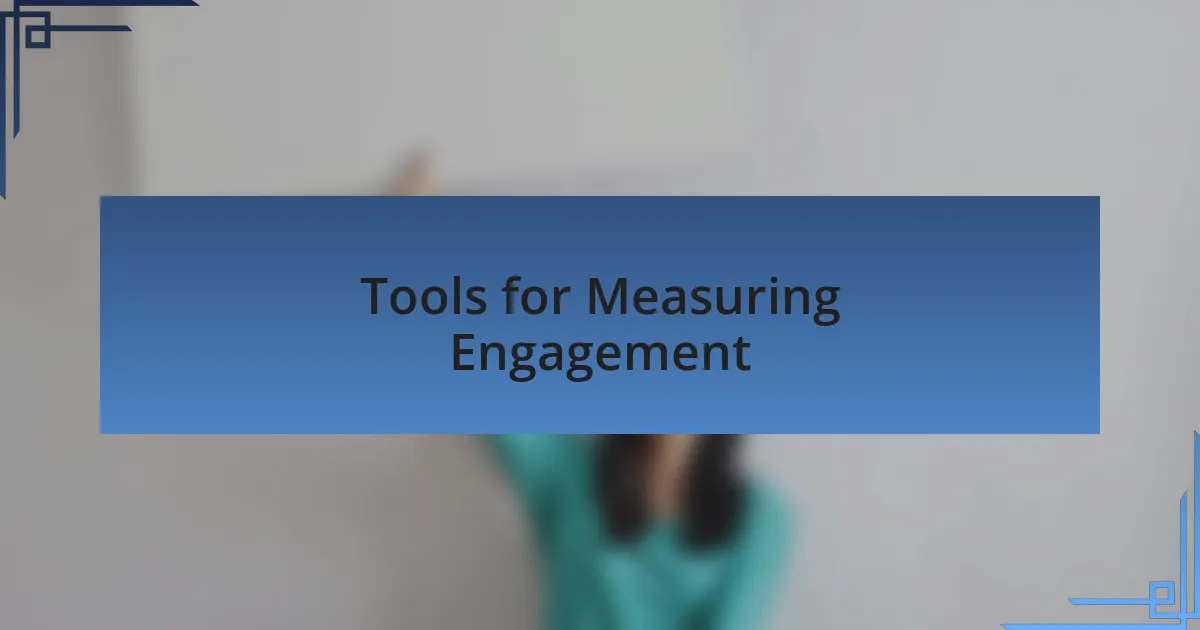
Tools for Measuring Engagement
When it comes to measuring user engagement, I can’t stress enough how pivotal the right tools can be. Google Analytics is my go-to for tracking user behavior. I remember the first time I set up conversion tracking; it was like turning on a light in a dark room. Suddenly, I could see which pages captivated my audience and which ones fell flat. Those insights were invaluable.
Aside from Google Analytics, I’ve found heatmap tools like Hotjar and Crazy Egg to be game-changers. They visually represent where users click and scroll, offering a perfect snapshot of engagement. Once, I realized that a call-to-action button was buried in a section of the page that hardly anyone visited. Adjusting its position based on heatmap data changed everything; engagement spiked almost overnight. Can you imagine the impact such visibility can have on your strategy?
Another tool I’ve come to rely on is social media analytics. Platforms like Facebook and Instagram provide insights into how audiences interact with posts. I recall launching a new campaign and monitoring the engagement metrics closely. The moment I noticed a particular post resonating, I pivoted my strategy to create more of that content. It taught me that real-time insights can guide your decisions and keep your audience engaged with what they crave.
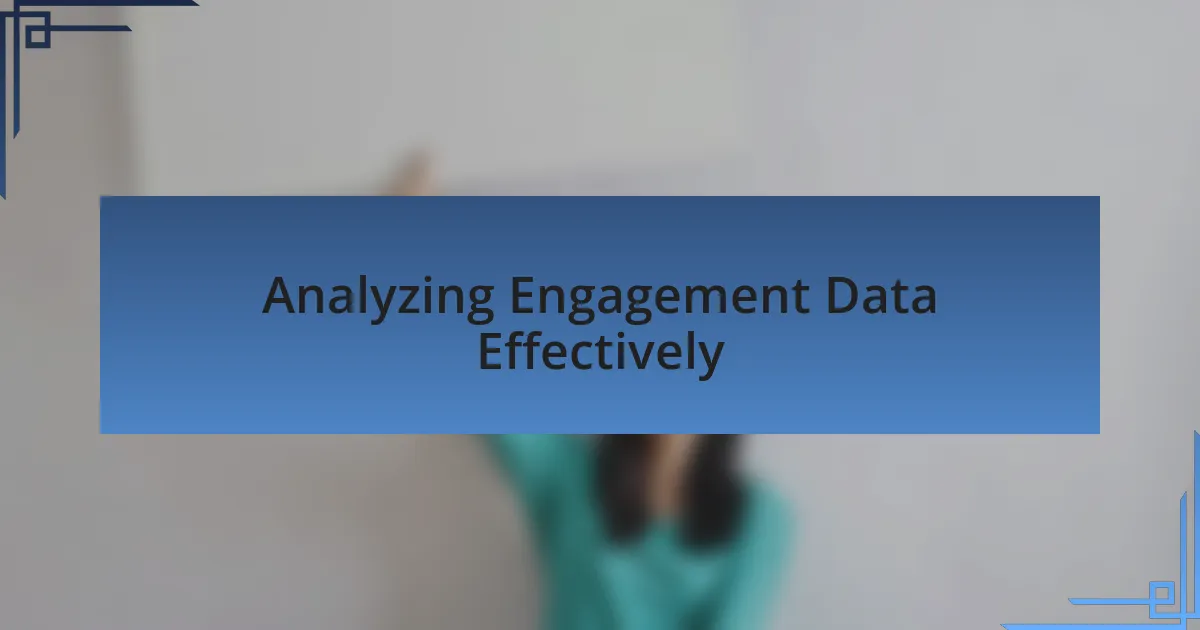
Analyzing Engagement Data Effectively
When analyzing engagement data, I believe it’s essential to focus on the metrics that truly matter. For instance, I often look at bounce rates alongside average session duration. Initially, I was puzzled by high bounce rates on certain pages until I realized those pages lacked compelling content. This revelation was a turning point for me—why attract visitors if they leave without engaging? Analyzing data with a discriminating eye lets us better tailor our content.
Diving deeper into user paths can be enlightening. I vividly recall a situation where I scrutinized users’ journey through my website and identified a drop-off at a specific stage in the checkout process. It was a moment of clarity; minor tweaks in the user interface led to increased conversions and significantly enhanced satisfaction. Have you ever noticed how small changes can lead to major shifts in user experience? Understanding these paths fosters a deeper connection with your audience.
Lastly, segmentation can transform how you interpret data. I once segmented my audience based on their behavioral patterns and discovered that those who engaged with newsletters showed higher conversion rates. It was fascinating to see how tailoring content to specific groups made my messaging resonate more. This approach not only improved engagement but also energized my strategy. Isn’t it amazing how targeted insights can invigorate your marketing efforts?
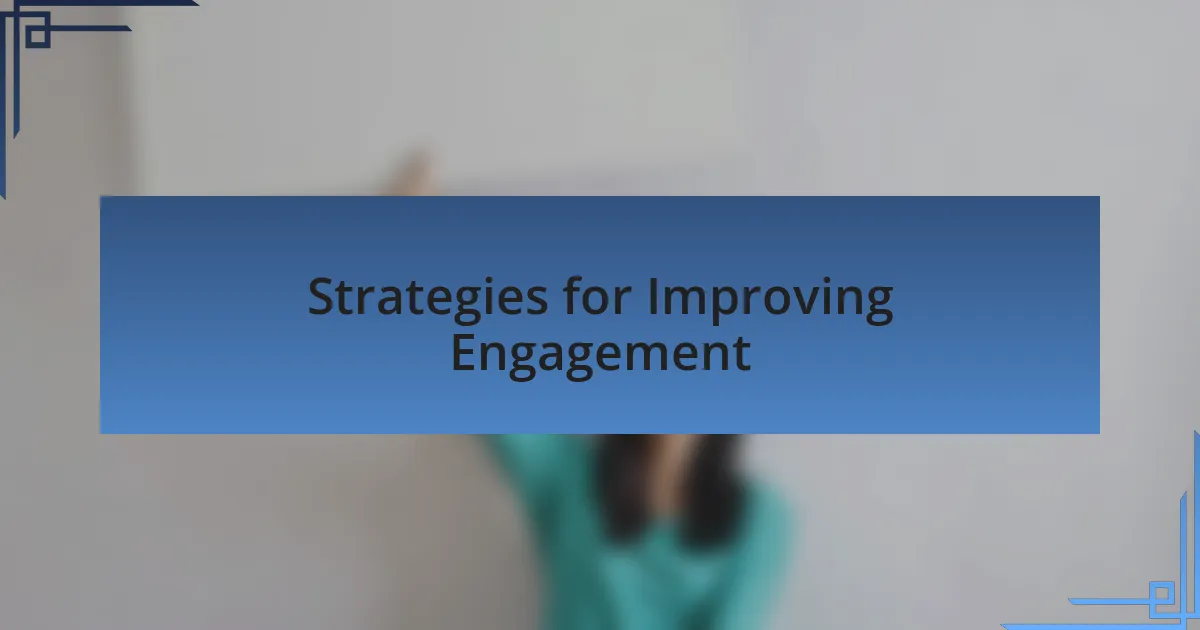
Strategies for Improving Engagement
To improve engagement, I’ve found that creating interactive content can be incredibly effective. I once developed a quiz designed to help visitors determine their digital marketing needs. The response was overwhelming! Not only did the quiz keep users on the site longer, but it also spurred social sharing, amplifying our reach. Have you ever noticed how engagement peaks when users can participate rather than just consume?
Another strategy that has worked wonders for me is optimizing the call-to-action (CTA). I remember when I revamped my CTAs from generic phrases like “Click Here” to more engaging prompts. The shift to more personalized and action-oriented wording led to a noticeable increase in clicks. It’s fascinating how the words we choose can influence behavior, isn’t it? Testing different CTAs continues to keep my audience interested and encourages them to take the next step.
Incorporating user-generated content has also been a game changer. Reflecting on a campaign where I encouraged customers to share testimonials and experiences on social media, I was thrilled to see increased trust and credibility. Witnessing the community rally around our brand not only elevated engagement but also created a sense of belonging. Have you ever wondered how powerful it is to let your audience be a part of your brand story?
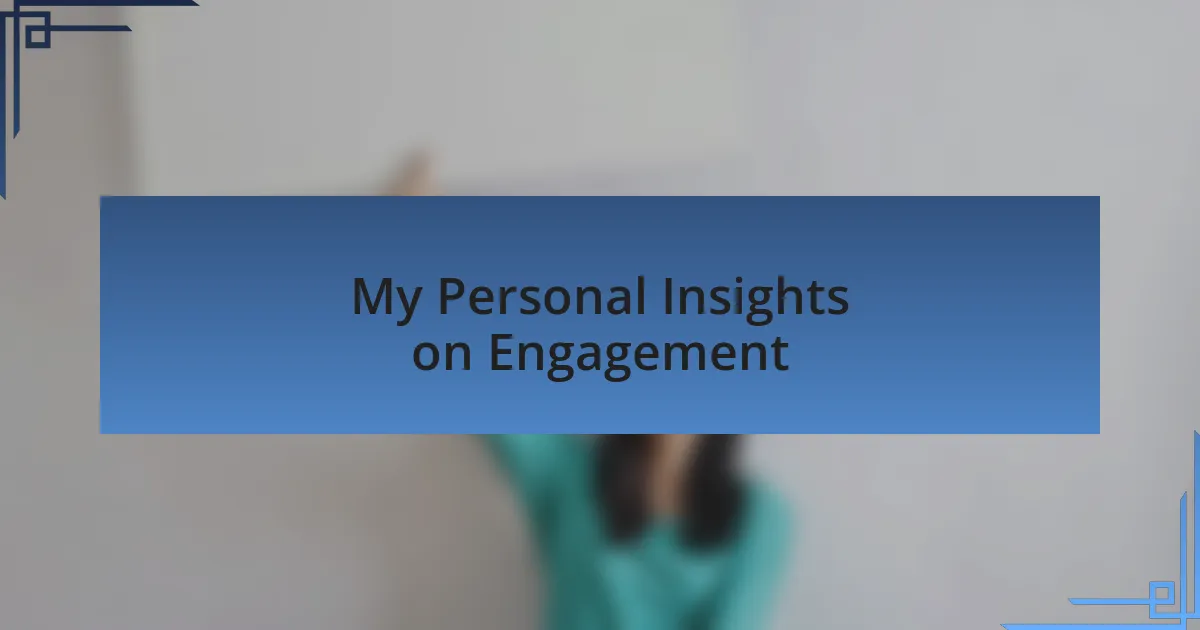
My Personal Insights on Engagement
Engagement, for me, often starts with the power of storytelling. I recall crafting blog posts where I shared not just facts but my own experiences in the industry. Readers responded positively, often commenting that they felt a personal connection. Isn’t it remarkable how sharing personal anecdotes can transform mere information into something relatable and engaging?
Additionally, I find that using data-driven insights to tailor content significantly boosts engagement. There was a time when I analyzed user behavior closely and discovered that specific topics resonated deeply with my audience. I pivoted my content strategy accordingly, focusing on their interests, and saw a substantial uptick in interactions. Have you ever considered how understanding your audience can lead to more meaningful conversations?
Finally, I believe that a sense of community enhances engagement profoundly. For example, I organized a virtual panel where industry experts and audience members could exchange ideas. The excitement in the room, albeit virtual, was palpable, and attendees expressed how valued they felt in that space. Have you thought about how fostering community can turn passive readers into active participants?
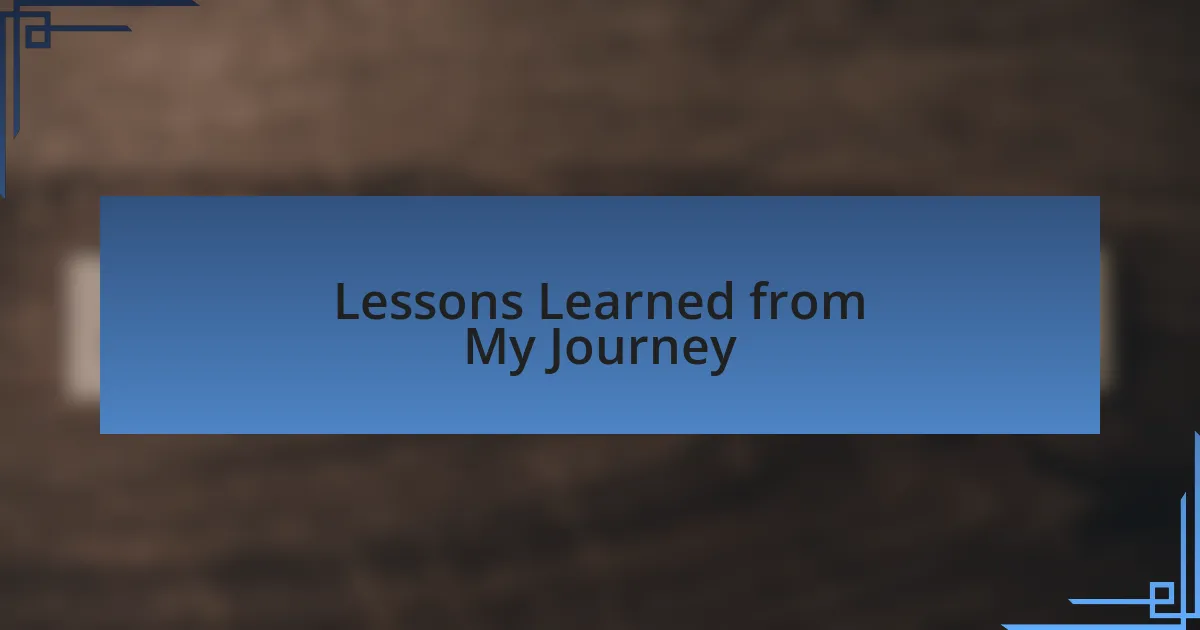
Lessons Learned from My Journey
One critical lesson I’ve learned is the importance of consistency. Early on in my journey, I was inconsistent with my posting schedule, and it showed in my user engagement metrics. When I finally committed to a routine, I noticed that my audience began to expect content from me, creating a sense of anticipation. Have you ever experienced the thrill of returning to a blogger who consistently delivers? It builds loyalty.
Another significant insight is the role of feedback in shaping content decisions. I remember a time when I received a handful of comments critiquing a more technical article I wrote. Instead of dismissing the feedback, I took it to heart and revised my approach, opting for simpler language. That pivot not only improved clarity but also increased my audience’s understanding and engagement. Isn’t it fascinating how feedback can be a guiding light for improvement?
Moreover, I’ve found that emotional connection is paramount. In one campaign, I shared a personal struggle related to my work, and the response was overwhelming. Readers reached out, sharing their own similar experiences, and it created a powerful dialogue. Don’t you think when we reveal our vulnerabilities, it paves the way for deeper connections? Engaging content isn’t just about data; it’s also about connecting on a human level.